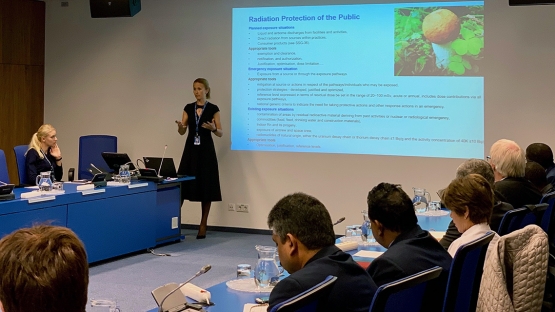Facilities ranging from nuclear installations to those using radioisotopes in industry, medicine and research often release small amounts of radioactive discharges to the atmosphere during their normal course of operation. Such releases from any new, modified and operating facilities need to be assessed, controlled and authorized. While protecting people from harmful effects of ionizing radiation remains the prime goal of radiation protection, the environment also needs to be protected.
To assist Member States in this work, the IAEA today organized an event introducing three recently published safety guides: Radiation Protection of the Public and the Environment (No. GSG-8); Regulatory Control of Radioactive Discharges to the Environment (No. GSG-9); and Prospective Radiological Environmental Impact Assessment for Facilities and Activities (No. GSG-10).
These guides support the IAEA safety standard publication entitled Radiation Protection and Safety of Radiation Sources: International Basic Safety Standards (No. GSR Part 3), the key publication on radiation safety setting standards for achieving high levels of radiation safety.
“The IAEA, in cooperation with Member State experts, has created these guides to help Member States to ensure that any releases are strictly controlled to protect the environment and the public,” said Miroslav Pinak, Head of the IAEA’s Radiation Safety and Monitoring Section in his opening remarks at the event attended by approximately 40 participants.
The three publications provide guidance to regulatory bodies in their work to:
- Conduct environmental impact assessments, which determine whether planned facilities or activities comply with current legislative and regulatory requirements on the protection of the public and the environment;
- Control and authorize discharges;
- Create a framework for protection of the public and the environment.
“Standards are only effective if they are properly applied in practice, and the Safety Guides show how to do so,” continued Pinak. During the side event, IAEA staff and Member States also discussed possible ways of implementing the new guidance.
To better understand challenges which Member States face in implementation, the IAEA in April 2019 organized a workshop on the three Safety Guides. The 35 experts from 22 Member States discussed how to promote the guides and what assistance is needed for different types of nuclear facilities and activities, such as through ongoing training mechanisms and national and regional technical co-operation projects coordinated by the IAEA.
The IAEA’s Modelling and Data for Radiological Impact Assessment programme (MODARIA), also helps Member States build experience in assessing the impact of radioactive releases to the environment.




